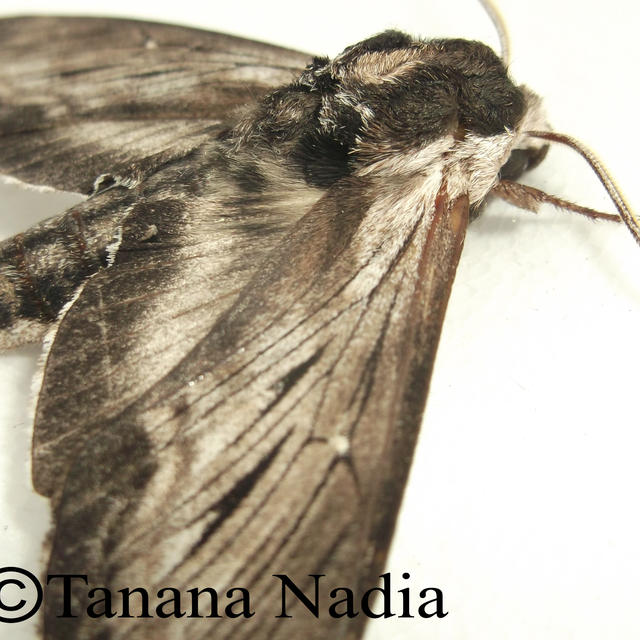Apple sphinx
Sphinx gordius Cramer, 1780
Family: Sphingidae
Subfamily: Sphinginae
Identification: Color and markings are highly variable. Fringes on forewing are mostly black with some white, those on the hindwing are mostly white with a few black patches. Forewing ranges from brown with black borders through brownish gray with paler borders to pale gray with no borders. Dashes, submarginal line, and cell spot are usually weak. Hindwing is gray to yellow-gray with a black border and a black median line which ranges from distinct to diffuse.
Wing Span: 2 11/16 - 4 1/4 inches (6.8 - 10.8 cm).
Life History: Caterpillars pupate in burrows in soft soil.
Flight: . One brood; from May-September in most of the range, from February-April in Florida.
Caterpillar Hosts: Apple (Malus), sweetfern (Myrica), Carolina rose (Rosa carolina), blueberry and huckleberry (Vaccinium), white spruce (Picea glauca), American larch (Larix laricina), and alder (Alnus).
Adult Food: Nectar from flowers including dogbane (Apocynum), honeysuckle (Lonicera), lilac (Syringa), evening primrose (Onagraceae), bouncing bet (Saponaria officinalis), and phlox (Phlox).
Habitat: Coastal barrens, bogs, and deciduous forests.
Range: Relative abundance varies throughout the range. Southeastern New York and New Jersey south to central Florida; west through southern Illinois, Colorado, and Utah; north through the Rocky Mountains to Manitoba.
Conservation: Not usually required.
NCGR: G4 - Apparently secure globally, though it might be quite rare in parts of its range, especially at the periphery.
Management Needs: None reported.
Comments: NULL
Get your BAMONA Gear!
Please donate!
We depend on donations to keep Butterflies and Moths of North America freely available. We want to express our gratitude to all who showed their support by making a contribution this year. You can donate to support this project at any time.
Advertise with us!
Do you have a product or service that you think would interest BAMONA users? If you would like to advertise on this website, contact us by email, or use the contact form and select the "Advertising" category.
Verified Sightings
Displaying 1 - 24 of 104 verified sightings

Observation date: May 20, 2023
Submitted by: David Trently
Region: Lackawanna County, Pennsylvania, United States
Verified by: curtis.lehman
Verified date: May 22, 2023

Observation date: Jul 03, 2016
Submitted by: disteffv
Region: Lackawanna County, Pennsylvania, United States
Verified by: curtis.lehman
Verified date: Dec 12, 2021

Observation date: Jul 16, 2021
Submitted by: BarbSendelbach
Region: Sussex County, New Jersey, United States
Verified by: curtis.lehman
Verified date: Jul 29, 2021

Observation date: Jun 27, 1997
Submitted by: DrBugs
Region: Uintah County, Utah, United States
Verified by: J_Martineau
Verified date: Feb 02, 2021

Observation date: Jul 04, 2020
Submitted by: J_Martineau
Region: Daggett County, Utah, United States
Verified by: J_Martineau
Verified date: Jan 05, 2021

Observation date: Jul 03, 2020
Submitted by: J_Martineau
Region: Carbon County, Wyoming, United States
Verified by: J_Martineau
Verified date: Jan 05, 2021

Observation date: May 20, 2012
Submitted by: wade wander
Region: Sussex County, New Jersey, United States
Verified by: curtis.lehman
Verified date: Oct 15, 2020

Observation date: Jun 06, 2020
Submitted by: Rick Welton
Region: Newton County, Indiana, United States
Verified by: rogerdowner
Verified date: Jun 09, 2020

Observation date: Jun 06, 2020
Submitted by: Rick Welton
Region: Newton County, Indiana, United States
Verified by: rogerdowner
Verified date: Jun 09, 2020

Observation date: Jun 29, 2018
Submitted by: Jim Eckert
Region: Berks County, Pennsylvania, United States
Verified by: curtis.lehman
Verified date: Oct 11, 2018

Observation date: Jun 29, 2018
Submitted by: Jim Eckert
Region: Berks County, Pennsylvania, United States
Verified by: Jim Eckert
Verified date: Jul 02, 2018

Observation date: Jun 21, 2016
Submitted by: iangardner
Region: Dauphin County, Pennsylvania, United States
Verified by: curtis.lehman
Verified date: Sep 29, 2016

Observation date: Jul 16, 2015
Submitted by: Aboover
Region: Knox County, Maine, United States
Verified by: Aboover
Verified date: Jul 17, 2015

Observation date: Jun 06, 2014
Submitted by: klebo
Region: Ocean County, New Jersey, United States
Verified by: curtis.lehman
Verified date: Feb 09, 2015

Observation date: Jun 12, 1987
Submitted by: Eric Olson
Region: Vilas County, Wisconsin, United States
Verified by: Tom Middagh
Verified date: Dec 26, 2014

Observation date: Aug 10, 2014
Submitted by: Zakyboy25
Region: New Hampshire, United States
Verified by: rogerdowner
Verified date: Aug 10, 2014

Observation date: Jun 18, 2014
Submitted by: mikeakresh
Region: Franklin County, Massachusetts, United States
Verified by: Lula Field
Verified date: Aug 05, 2014

Observation date: Jul 11, 2014
Submitted by: joeverica
Region: Centre County, Pennsylvania, United States
Verified by: curtis.lehman
Verified date: Jul 12, 2014

Observation date: Jun 21, 2013
Submitted by: TananaNadia
Region: Carbon County, Pennsylvania, United States
Verified by: curtis.lehman
Verified date: Jun 21, 2013
Observation date: Jul 08, 1999
Submitted by: curtis.lehman (Paul Dennehy)
Region: Sullivan County, Pennsylvania, United States
Verified by: curtis.lehman
Verified date: Feb 08, 2013
Observation date: Jul 09, 2003
Submitted by: curtis.lehman (Paul Dennehy)
Region: Columbia County, Pennsylvania, United States
Verified by: curtis.lehman
Verified date: Feb 08, 2013

Observation date: Jun 17, 2007
Submitted by: Jim Brighton
Region: Garrett County, Maryland, United States
Verified by: rogerdowner
Verified date: Feb 21, 2012

Observation date: Aug 11, 2011
Submitted by: BOGwalker
Region: St. Louis County, Minnesota, United States
Verified by: Tom Middagh
Verified date: Jan 30, 2012

Observation date: Jul 28, 2011
Submitted by: BOGwalker
Region: St. Louis County, Minnesota, United States
Verified by: Tom Middagh
Verified date: Jan 17, 2012
- 1 of 5
- next ›






